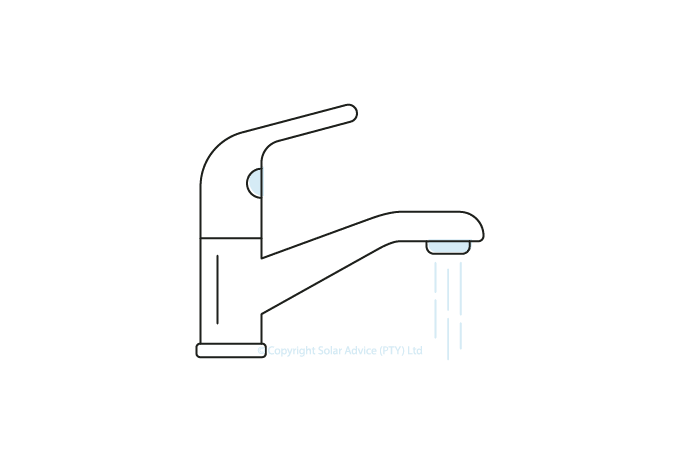If you’re considering embarking on your solar power journey but don’t know where to start, Solar Geysers and Solar Geyser Conversion Kits are the best place to begin .
Electric Geysers account for between 30% – 50% of your monthly electricity bill .
While this number is staggering, there is a solution: installing a Solar Geyser will help you save money every month .
Our kits come with a five-year standard warranty and have a life expectancy of 15+ years.
In this guide, you’ll learn about the different types of Solar Geysers , how they work and which option would best suit your needs.
Here’s what we’ll be covering:
- Fundamentals
- Kit Includes
- Solar Geyser Kit Types
- Solar Collectors Explained
- Geyser Sizes
- Case Studies
- Solar Solar Geyser Prices
- Installation
- Conclusion
Chapter 1
Solar Geysers: Fundamentals
As always, let’s start with the fundamentals
There may be a few words and abbreviations that you’ll need to know before we get into the fun stuff, especially if you are new to the topic.

Solar Collector

A Solar Collector is the ‘panel’ that is installed onto your roof. There are two different types, an Evacuated Tube Collector and a Flat Plate Collector.
Evacuated Tube Collector

The Evacuated Tube Collector, also known as an EVT for short, is a highly efficient solar collector. Keep reading to learn more.
Flat Plate Collector

A Flat Plate is a type of solar collector that uses heat from the sun to heat water. Keep reading for more details.
Retrofit / Conversion Kit

A conversion kit is a set up that enables you to turn a standard electric geyser into a solar geyser.
Thermosyphon Solar Geyser

A Thermosyphon Solar Geyser is a solar collector AND geyser that is installed on top of your roof.
Thermal Controller

A thermal controller allows you to set a maximum water temperature, and it also allows you to set a time during the day or night when you want your geyser element to be switched on.
Chapter 2
Solar Geysers: Kits Includes
What’s included in the kit
For the most part, a solar geyser set up includes:
- A geyser tank (new or pre-existing)
- A solar Collector (EVT or Flat Plate)
- A Thermal Controller
- Various valves
- And in conversion kit cases, a 220V pump.

Chapter 3
Solar Geysers: Kit Types
Understanding the different kit types
We’ll discuss how they work, the differences between the two systems and each of their benefits.
Both of the systems are very different from each other, but they both have the same goal: to heat your water using the sun, which will ultimately save you money on your electricity bill.


Thermosyphon Solar Geysers
The Thermosyphon Solar Geyser setup requires both the solar collector and the geyser be installed on top of your roof. The geyser is positioned above the flat plate or evacuated tube collectors.
The Thermosyphon system uses a process called convection and conduction.
These processes refer to the heating of water (in this case), decreasing its density allowing it to move upwards to the geyser. Simultaneously, the colder water has a higher density, allowing it to fall into the solar collector where it will be heated, and the whole cycle begins again.
These systems have no moving parts, making them highly reliable, with little to no maintenance needed.
The Solar Geysers prices are higher than the conversion kits because they include a geyser. With that said, you will save money and time not having the hassle of maintenance on these systems.
The geysers included in these kits have electric elements in them too so that you are not entirely reliant on the collector, especially during the night.

Solar Geysers: Retrofit / Solar Geyser Conversion Kits
Retrofit kits turn electric geysers into solar geysers.
Your electric geyser will remain in its original position, with the solar collector installed on top of your roof.
They are connected, but because the geyser sits below the solar collector, you cannot use thermosyphon to get your water to the solar collector and back again.
A pump is needed to syphon water from the geyser to the solar collector.
This is where the thermal controller plays an even more significant role than previously stated.
The thermal controller regulates the water temperature, but it also tells the pump when to switch on and send water to the solar collector and back to the geyser.
This type of solar geyser solution works very well, but you may require extra maintenance because it has mechanical/moving parts.
For example, if the pump stops working, you’ll need to replace it. They are not very expensive though and are readily available.
Chapter 4
Solar Geysers: Solar Collectors
The different types of collectors
Your roof direction, average weather conditions and whether or not you have obstructions will determine what collector would best suit you.
Let’s start by comparing the two types of solar collectors.


Flat Plate Collectors
A flat plate solar collector is perfect for our weather conditions here in South Africa.
They have a heat-absorbing plate, glazing material (plastic or glass), a series of copper tubing and insulation.
The water inside the copper tubes is heated by the sun thanks to the conductive materials that make up the flat plate solar collector. The insulating materials ensure that very little heat is lost throughout the circulation process.
Flat Plate Solar Collectors should always be installed on a north-facing roof and in full, unobstructed sunlight.
These solar collectors are the most cost-effective solar collector type thanks to their simple design, low manufacturing cost, and easy installation.
Suppose your roof meets the above criteria, congratulations! The flat plate collector is perfect for you.
If you’d like more information on how they work, read the Wikipedia page.
Visit Wikipedia
Evacuated Tube Collectors
These types of solar collectors are ideal for conditions where your solar collector is shaded either by frequent cloud cover or other obstructions like trees and chimneys.
Evacuated Tube Collectors are the most efficient type of collector as full sun is not a necessity. Because the tubes are round, they can harvest heat from all directions.
Each tube has a glass exterior and contains a heat absorber plate and a sealed heat pipe inside them. The air inside the tubes is wholly removed, forming a vacuum seal.
Heat pipes are long, sealed copper tubes with a copper bulb at the top. The heat pipe’s length is inside the glass tube, and the bulb is inside the manifold.
Each heat pipe has a small amount of water and alcohol inside them. Thanks to the vacuum seal, the alcohol/water mix is heated up and creates a hot vapour that rises to the top of the heat pipe’s bulb.
A heat transferring liquid transfers the heat generated in the heat pipe bulb to the water that flows from your geyser into the collector’s manifold. Once the water is heated, it is sent back down to your geyser.

Chapter 5
Solar Geysers: Sizes
Your standard geyser sizes are 100L, 150L and 200L. There are bigger sizes but let’s focus on these three.

You can even have 2 geysers in series which works well if you are looking for geysers larger than 200L.
You will still use your electric element to ensure you have hot water during the night time and early morning . Even Thermospyphon Solar Geysers have electric elements for this reason.
100L
You will usually find 100L geysers in small homes. These geysers are perfect for 2-3 people.
150L
150L geysers work well for small to medium-sized homes. They work well for 3-4 people.
200L
200L geysers are found in medium-sized homes. They’re suited to families with 4-5 people.
Solar Geysers: Case Study 1
Sylvia
Small to medium sized family
She wants to start saving money on her monthly electric bill and has decided to start with her geyser.
She had decided to convert her electric geyser using a Retrofit Conversion Kit.

We have two options for Sylvia. She can either have a Flat Plate Conversion Kit or an Evacuated Tube Conversion Kit.
She has the perfect conditions for a Flat Plate Collector, so she’ll go that route.
Solar Geysers: Case Study 2
Terry
Medium sized family
They are spending a fortune every month on electricity. They, too, would like to transition from an electric geyser to a solar geyser.
Their home is in an area where there is lots of cloud cover and rain throughout the year.

This kit will ensure that they are still able to heat their water, even on overcast days, thanks to the high efficiency of the EVT Solar Collector.
Terry and his family will be saving money in no time.
Solar Geysers: Case Study 3
Mr & Mrs Murphy
Large sized family
They often have guests staying over at their 5 bedroom home, so they needed to ensure that they had enough hot water.
They installed 2 x 200L Thermosyphon Solar Geysers along with a Solar Power Kit to help keep electricity costs at a minimum.

Because this system has no mechanical parts, they do not have to worry about maintaining their geyser.
And, they have peace of mind knowing that they have plenty of hot water available to their family and their guests.
Affordable Solar Geysers
What can you expect to pay?

Flat Plate Conversion Kits range from R 8,909.45 – R 9,650.97
EVT Conversion Kits range from R 10,105.45 to R 12,198.45
Thermosyphon Kits range from R 12,843.19 to R 16,970.29
Solar Geyser Installation
What you need to look out for.
With regards to the cost of a solar geyser installation, you’re looking at around R4,500.00 + this price may differ from installer to installer. Hence, it’s always best to spend a bit of researching reputable installers.
Look for positive reviews and even ask for references to ensure you are getting the best service.

Solar Geysers: Conclusion

Solar Advice prides itself on being one of the best solar geyser suppliers in South Africa .
We have several solar geysers for sale and conversion kits for existing 100L, 150L and 200L geysers .
We deliver Solar Geysers to Johannesburg and Cape Town.
If you are still unsure of which system would be best for you, please feel free to contact us .
